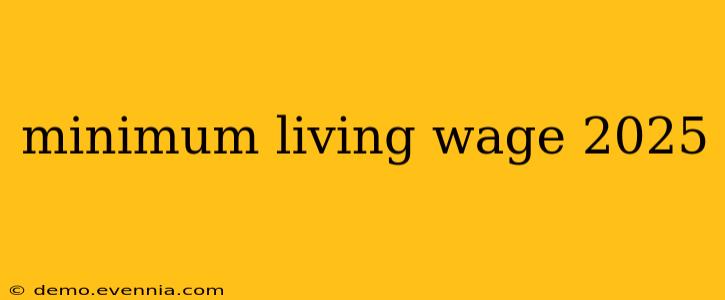The minimum wage is a hotly debated topic, constantly evolving with economic shifts and societal pressures. Predicting the minimum living wage in 2025 requires analyzing current trends, considering inflation, cost-of-living adjustments, and potential legislative changes. While a precise figure is impossible to definitively state, this article explores projections and their broader implications.
Understanding the Minimum Living Wage
Before delving into projections, it's crucial to understand what constitutes a "living wage." Unlike the legally mandated minimum wage, a living wage is a calculated amount deemed necessary to meet a family's basic needs, including housing, food, transportation, healthcare, and childcare. This calculation varies significantly based on location (rural vs. urban, state vs. state), family size, and the specific basket of goods and services considered.
Several organizations, such as the MIT Living Wage Calculator and the Economic Policy Institute, regularly publish living wage estimates for different regions. Their methodologies, while varying slightly, generally consider factors such as:
- Housing costs: This often forms the largest component, reflecting the significant variation in rental or mortgage expenses across locations.
- Food costs: Calculations incorporate the cost of a nutritious diet suitable for a family of the specified size.
- Transportation costs: This accounts for commuting expenses, including public transportation or car ownership and operation.
- Healthcare costs: The rising cost of healthcare, including insurance premiums and out-of-pocket expenses, is a key factor.
- Childcare costs: For families with children, childcare expenses can significantly impact the living wage calculation.
Projected Minimum Living Wage in 2025: A Range of Possibilities
Predicting the exact minimum living wage in 2025 is challenging due to inherent uncertainties. However, we can analyze current trends and extrapolate potential scenarios:
-
Inflationary pressures: Inflation is a major driver. If inflation remains high, the living wage will likely need to increase proportionally to maintain its purchasing power. Economists' inflation predictions vary, leading to a range of possible living wage outcomes.
-
Legislative changes: Policy changes at the federal, state, or local levels could significantly impact minimum wages. Some jurisdictions are actively pursuing increases in minimum wages to keep pace with the cost of living. Others might see minimal changes or even stagnation.
-
Economic growth: A robust economy generally leads to upward pressure on wages across the board, potentially influencing minimum wage calculations. Conversely, economic downturns may slow or even reverse these increases.
-
Technological advancements: Automation and technological progress could impact employment and wages. While technology can boost productivity, it could also lead to job displacement in certain sectors, impacting the need for a living wage.
Considering these factors, a realistic projection for the minimum living wage in 2025 would likely fall within a broad range, varying significantly based on geographic location and the specific methodology used for calculation. Some areas may see increases far exceeding the current minimum wage, while others might experience more moderate adjustments. Therefore, instead of providing a specific numerical prediction (which would be unreliable and potentially misleading), it’s more informative to focus on understanding the underlying forces that will shape the living wage in the coming years.
Policy Implications and Future Outlook
The minimum living wage debate is far from over. Policymakers face a delicate balancing act between protecting low-wage workers and maintaining economic stability. Potential policy implications include:
- Indexed minimum wages: Linking minimum wages to inflation could help ensure that they maintain their purchasing power over time.
- Geographic adjustments: Recognizing the significant variation in living costs across regions would necessitate tailored minimum wage levels.
- Support for low-wage workers: Expanding access to affordable healthcare, childcare, and housing could alleviate some of the pressures associated with a low minimum wage.
The minimum living wage in 2025 will be the product of these complex economic and political dynamics. Continuous monitoring of inflation, cost-of-living indices, and legislative actions will be essential in tracking its evolution. Further research and analysis from reputable economic institutions and think tanks will offer more refined predictions as we approach 2025.

